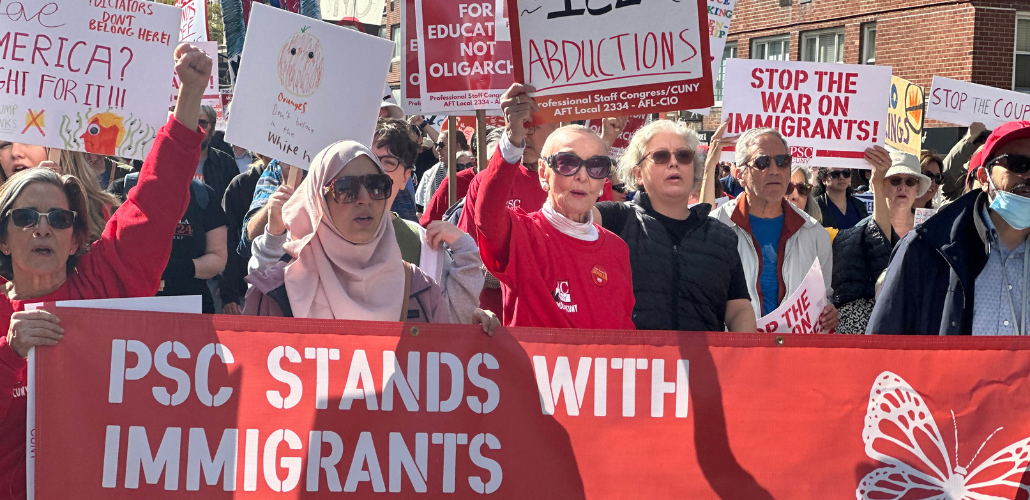How to Build a Union Culture that Welcomes Immigrant Members

Approach immigrant workers in an open, straightforward manner and see what you can learn. Photo: Luis Feliz Leon
Solidarity between workers is the lifeblood of a fighting labor movement. The workplace throws us together regardless of culture, race, gender, and language; we may have little in common but the need to earn a livelihood. But working shoulder to shoulder, we forge genuine bonds.
By breaking bread together or facing down tyrannical supervisors together, we build trust. We begin to generate a class culture, to establish norms for behavior on the job. Everywhere I’ve ever worked, I got my real orientation not from H.R. but from my co-workers. I learned that, no matter the differences among us, a boss is a boss is a boss—and we aren’t family!
The bosses fear our collective power, so they try to pit us against each other. But where they stoke divisions, we can draw on shared values to unite us. The more workers are active in the union, the greater our power on the job. The boss wants total control. That’s why our differences—workers vs. bosses—are irreconcilable.
The Trump administration has unleashed a maelstrom of attacks against immigrant workers. Federal agents are sowing terror among immigrants and citizens alike, and racially profiling us Latinos for kidnapping and detention. Who benefits? Trump and his CEO pals do. A fearful workforce won’t stand up for safety or demand fair treatment on the job.
If there’s one thing to remember about Donald Trump, it’s that he’s a boss—he wants us divided so that he can keep the upper hand. And if ever there was a time to stand up to a boss and declare that “an injury to one is an injury to all,” it’s now.
Find advice on defending members from the current attacks in our collection of Resources for Immigrant Workers and Allies. The following article, adapted from a piece Dan La Botz wrote in A Troublemaker's Handbook 2, is about building a welcoming culture in your local.
—Luis Feliz Leon
Here is some basic advice for union officers and activists who are new to working with immigrant members. You probably already know that immigrant workers want pretty much the same things any unionized worker wants. A decent job. A living wage. Respect and trust. Some measure of control over their lives.
The other thing you should know is: Don’t presume to know anything. Forget stereotypes. Approach immigrant workers in an open, straightforward manner and see what you can learn.
Many immigrants may have as much to teach you about the labor movement as they have to learn. Some may have been involved in labor, political, or even revolutionary movements in their native countries.
Others may be professionals—doctors or teachers—but because of citizenship and licensing issues find themselves working in lower-skill jobs here, or gaining new skills. A surgeon becomes a taxi driver. A lawyer scrubs airport toilets.

SUPPORT LABOR NOTES
BECOME A MONTHLY DONOR
Give $10 a month or more and get our "Fight the Boss, Build the Union" T-shirt.
Here are some guidelines:
- Immigrants can be capable leaders, with a wealth of experience to draw on in fighting against oppressive conditions. If you wish to reach an immigrant social group, you will need to identify the natural leaders within it—just like with any other group—and involve them in meaningfully leading the effort.
- Immigrant workers aren’t homogenous. Not everyone from Latin America speaks Spanish, and many come from Afro-Latino, indigenous, or other racial and ethnic backgrounds. Upper-class people or professionals have goals that can potentially conflict with those of blue-collar workers.
- Translate organizing materials into the appropriate language(s). Translate the union constitution and bylaws, contracts, health and pension plans, newsletter, and website, even though doing so may be expensive. Immigrant members cannot participate as equals without these tools. Translate a glossary of useful union terms. Encourage use of translation apps. Don’t worry about sounding dumb or getting something wrong: making a sincere effort goes far, especially when you are willing to laugh at yourself!
- Provide interpretation at all meetings, or conduct them in the workers’ language. If your budget allows it, the best way is to hire professional interpreters; ideally, monolingual English speakers should use interpretation equipment too, so the playing field is leveled. But for informal gatherings, interpreters do not necessarily have to be professionals—they can even be the children of union members or community allies. The point is to break down barriers to communication and provide a welcoming environment. Make sure interpreters are familiar with union terminology.
- Be sensitive to religion and customs. Find out the days and times of religious or national holidays, to avoid scheduling conflicts. Be open to adapting union events to incorporate the practices of immigrant members. What kinds of food and music will make the union picnic feel welcoming? Putting the weight of the union behind immigrant members’ fights for inclusion on the job, like the right to prayer breaks, can also go a long way.
- Identify capable immigrant activists and promote them as stewards, committee members, and spokespeople. Immigrants will not take the union seriously as their own organization if people like them are excluded from leadership positions. Note, however, that people resent being pigeonholed as ethnic spokespersons—they must become leaders in the union at large, not just one of its enclaves.
- Educate each other on questions that arise from people’s politics, race, ethnicity, gender, immigration status, etc. Open discussion of issues like police harassment or racism may help other workers better understand the immigrant workers’ problems and promote overcoming divisions. But make the conversations two-way dialogues to confront differences head on, rather than brush them under the rug. Just like anyone, immigrant workers can have conservative political views. Don’t patronize them—challenge them on it!
- Listen to understand and identify shared values. Some members may believe the myth that undocumented immigrants could have simply “gotten in line” to come here legally. Some may express their own economic concerns through rhetoric about immigrants “taking jobs” and “holding down wages.” It’s tough to argue with a feeling, and telling someone they’re wrong will usually just get them defensive. Highlight areas of common ground: We’re all worried about making enough to take care of our families. This new safety hazard puts us all at risk. When you’re tempted to make a statement, ask a question instead: Who benefits when workers are afraid to stand up? Who benefits when we are divided?
- Immigrant workers can help the rest of us understand the global economy and the impacts of U.S. policy. When workers from southern Mexico explain that they came to the United States because of the collapse of their rural economy, American workers may learn more about NAFTA than they would in a year of union newsletter articles. And many immigrants are here because the U.S. Marines and CIA were there, overthrowing democratic governments to install dictators. So we may also have something to learn about resisting authoritarian regimes.





